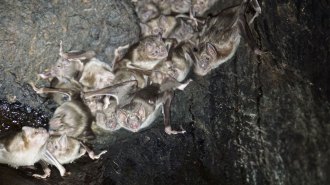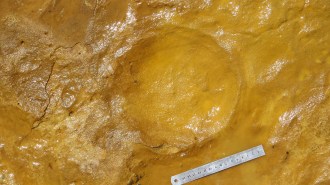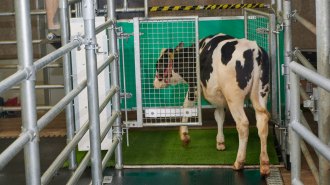Life
Sign up for our newsletter
We summarize the week's scientific breakthroughs every Thursday.
-
 Animals
AnimalsBloodthirsty vampire bats like to drink with friends over strangers
Cooperation among vampire bats extends beyond the roost. New research suggests that bonded bats often drink blood from animals together.
-
 Genetics
GeneticsDNA offers a new look at how Polynesia was settled
Modern genetic evidence suggests that statue builders on islands such as Rapa Nui, also known as Easter Island, had a shared ancestry.
By Bruce Bower -
 Health & Medicine
Health & MedicineBy taking on poliovirus, Marguerite Vogt transformed the study of all viruses
She pioneered the field of molecular virology with her meticulous lab work and “green thumb” for tissue culture.
-
 Paleontology
PaleontologyFossil tracks may reveal an ancient elephant nursery
Fossilized footprints at a site in Spain include those of an extinct elephant’s newborns, suggesting the animals may have used the area as a nursery.
By Sid Perkins -
 Animals
AnimalsSome birds learn to recognize calls while still in their eggs
For over a decade, behavioral ecologist Diane Colombelli-Négrel and colleagues have been studying how birds perceive sounds before hatching.
-
 Humans
HumansFossils and ancient DNA paint a vibrant picture of human origins
Paleoanthropologists have sketched a rough timeline of how human evolution played out, centering the early action in Africa.
By Erin Wayman -
 Agriculture
AgriculturePotty-trained cattle could help reduce pollution
About a dozen calves have been trained to pee in a stall. Toilet training cows on a large scale could cut down on pollution, researchers say.
-
 Animals
AnimalsMary Roach’s new book ‘Fuzz’ explores the ‘criminal’ lives of animals
In “Fuzz: When Nature Breaks the Law,” author Mary Roach profiles mugging monkeys, thieving bears and other animal outlaws.
-
 Life
LifeA beautiful oak leaf portrait won the 2021 Nikon Small World photography contest
The annual competition showcases otherworldly photos that capture microscopic features of nature and science.
-
 Environment
Environment50 years ago, chemical pollutants were linked to odd animal behavior
Fifty years after studies hinted that pollution interferes with how aquatic creatures communicate, scientists are still unraveling its myriad effects.
By Aina Abell -
 Animals
AnimalsA newfound boa sports big eyes and a square nose
Among the smallest boas in the world, the Hispaniolan vineboa inhabits a small patch of dry forest along the Dominican Republic’s border with Haiti.
-
 Life
LifeInfants may laugh like some apes in their first months of life
Laughter seems to change over life’s early months, perhaps influenced by the unconscious feedback parents give when they play with their little ones.